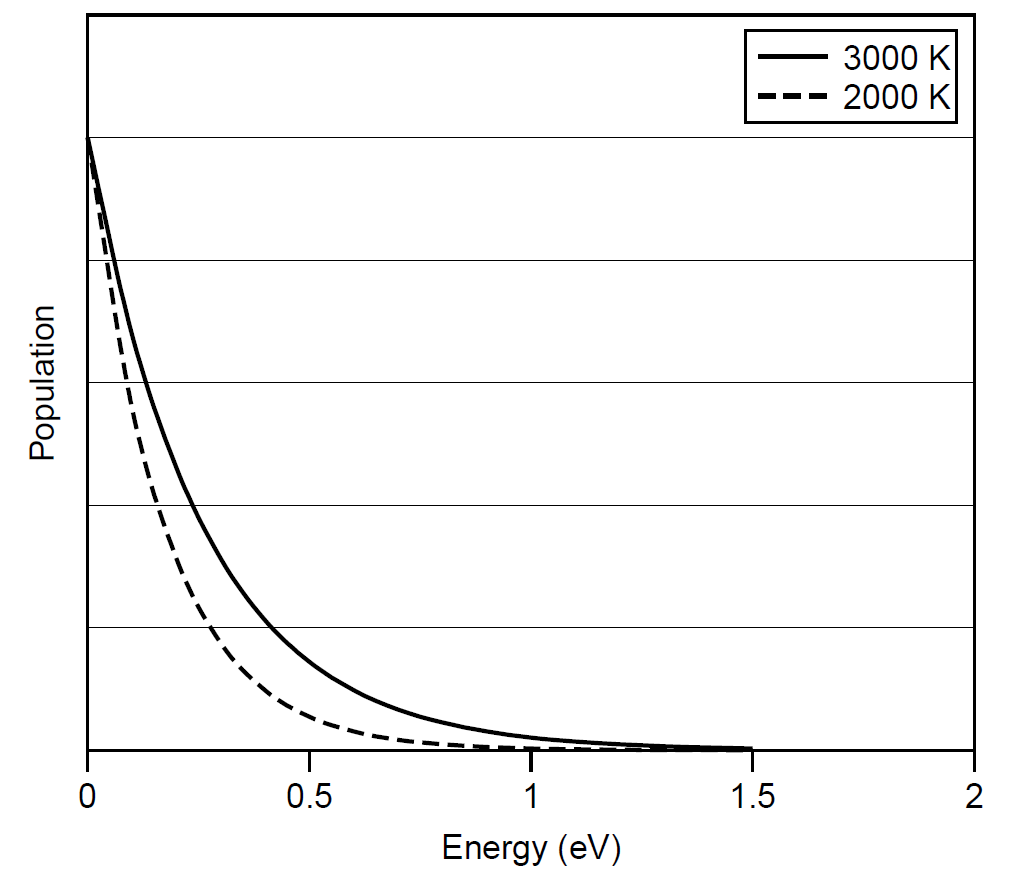
BOLTZMANN DISTRIBUTION AND THERMAL EQUILIBRIUM
 المؤلف:
Mark Csele
المؤلف:
Mark Csele
 المصدر:
FUNDAMENTALS OF LIGHT SOURCES AND LASERS
المصدر:
FUNDAMENTALS OF LIGHT SOURCES AND LASERS
 الجزء والصفحة:
p86
الجزء والصفحة:
p86
 10-3-2016
10-3-2016
 1428
1428
BOLTZMANN DISTRIBUTION AND THERMAL EQUILIBRIUM
That atomic populations of a system without an external source of energy are governed solely by temperature according to a Boltzmann distribution (Figure 1.1). This distribution predicts an exponential drop in atomic populations of higher energies. Recall that a central concept of quantum mechanics is the condition that atomic energies are confined to certain allowed, discrete states. Applying Boltzmann’s law, we may now predict the population of atoms at each discrete energy state.
Consider mercury atoms. The first energy level is at 4.66 eV above ground, or (multiplying by 1.602 × 10-19 J/eV) 7.46 × 10-19 J. If we have 1 mole of atoms (6.02 × 1023 atoms, a standard quantity in chemistry and physics) at ground state, then at room temperature (293 K) the number of atoms at this high-energy state is on the order of 10-57! It is fair to say that there are essentially no atoms with an energy this high at room temperature, so no light will be emitted from the mercury, as no transitions are possible. Now, if the temperature is increased to, say, 2000 K, the population of atoms at this particular energy level increases to 1012. A sizable concentration at this energy level will lead to emission of light when these atoms lose their energy by emitting photons and falling

Figure 1.1. Boltzmann distribution of atomic energies at various temperatures.
back to ground state. Experience tells us that anything heated to 2000 K (e.g., an electric stove element) will emit light in the form of a glow.
Such a system is said to be at thermal equilibrium. The population of atoms at any given energy level is governed solely by temperature, since there is no external source of energy. As we have seen from the calculations, if the temperature of the entire system were raised, the distribution would shift and more atoms would reach higher energies. However, the population of a lower level will always exceed that of a higher level. Had we chosen an incandescent lamp (a “blackbody radiator”), the situation would be the same. Electrical energy heats a tungsten filament. Many atoms at high energies drop to a lower-energy state and in doing so, emit a photon of light. The difference in energy between the upper and lower energy states for the transition is manifested as the photon energy and hence the wavelength of the emitted light. In such a system, there are a large number of upper and lower levels, and these levels may span a range of energies so that the output from such a source is broadband. It is not at a single discrete wavelength like the line spectra emission from our gas, but rather, spans a range of wavelengths. No matter how the example above is considered, the situation still arises where there is a higher population of atoms at lower than at higher energy states.
 الاكثر قراءة في بعض تطبيقات الليزر
الاكثر قراءة في بعض تطبيقات الليزر
 اخر الاخبار
اخر الاخبار
اخبار العتبة العباسية المقدسة


